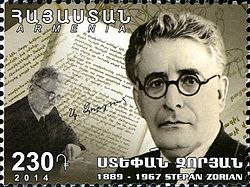Stepan Zorian started his literary career in pre-Soviet times and managed to become one of the outstanding names of the elder generation of Soviet Armenian literature.
His actual last name was Arakelian. He was born on September 15, 1889, in Gharakilise (nowadays Vanadzor), into the family of a villager. He studied for two years in the clandestine school of teacher Zakar (1896-1898) and then was admitted to the newly opened Russian school, graduating in 1904. The Russian government had shut all Armenian schools in those years.
This was the end of Zorian’s education. He went to Tiflis, but could not enter the Nersesian School, because his financial situation forced him to work, first as a copyeditor at a printing house, then as translator at the Surhandak newspaper, followed by translator and style corrector at the daily Mshak (1912-1919). In 1909 he published his first short story in the press and in 1918 his first collection of short stories, Sad People, which earned him praise from readers and critics.
Zorian moved to Yerevan in 1919 and worked at the monthly Hayastani kooperatsia until the end of the independent republic. He held different positions afterwards: editor in chief of the State Publishing House (1922-1925); vice-president of the Armenian Proletarian Writers Union (1927-1928); member of the Central Executive Committee of Soviet Armenia (1929-1935); literary consultant of Armenkino, the Armenian film company (1930-1934), and Secretary of the Writers’ Union of Armenia (1950-1954).
Stepan Zorian’s collections of classically written short stories and the two-volume novel “History of a Life” (1939) had earned him a solid place in Soviet Armenian literature before World War II. During the war, when patriotic literature was allowed to flourish as a way to support the war effort, the writer published the novel “King Pap” (1944) about the Armenian king of the fourth century A.D., extolling the subject of homeland defense. The novel was reprinted many times in Armenia and the Diaspora, and became synonymous with Zorian’s name. He also published the sequels “The Armenian Fortress” (1959) and “Varazdat” (1967). By then, his works had been published in six-volume (1940-1954) and ten-volume (1960-1964) editions. He was a member of various cultural and publishing boards, and participated in the academic editions of the works of various writers, like Khachatur Abovian and Hovhannes Tumanian. He became a member of the State Committee for the all-Soviet Lenin Prizes in 1962 and president of the Committee of State Prizes of Literature, Art, and Architecture of Armenia in 1965. Also in 1965, he was elected a full member of the Armenian Academy of Sciences. He was also a member of the Soviet Supreme of Armenia in the 1960s and was decorated several times. His works were translated into many languages. Armenfilm studios produced the movies “Near the Well” (1968) and “The President of the Revolutionary Committee” (1977), based on short stories by Stepan Zorian.
The prolific writer passed away in Yerevan on October 14, 1967, and was buried in the Komitas Pantheon. In 1972 the house-museum of Stepan Zorian was opened in his birthplace, Vanadzor (called Kirovakan in Soviet times). It was partially destroyed by the earthquake of 1988 and restored in 1990. In 1980 a prize named after Zorian was established for literary translators into and from the Armenian language. An academic edition of his works in twelve volumes was posthumously published between 1977 and 1990.

